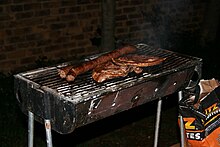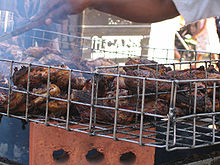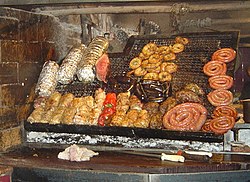Evaluating Meat Texture and Flavor Absorption: Dry Rubs vs. Wet Marinades
When preparing for a spit braai, one of the key decisions any chef faces is whether to use a dry rub or a wet marinade to enhance the meat's flavor and texture. Both techniques have their advocates and can significantly influence the outcome of your barbecued meat. Here, we delve into each method to determine which might be best suited for a spit braai.
Dry Rubs: The Flavorful Crust Approach
Dry rubs consist of spices, herbs, and seasonings that are rubbed directly onto the surface of the meat before cooking. The composition of a dry rub can vary widely but commonly includes elements like salt, pepper, paprika, garlic powder, onion powder, and sometimes sugar. When applied to meat, these dry ingredients adhere to the surface and create a crust that not only adds intense flavor but also helps in retaining the natural juices of the meat.
The primary advantage of using a dry rub for spit braai lies in its ability to form this flavorful crust without adding additional moisture. During the slow roasting process over an open flame, this crust becomes wonderfully caramelized and textured. This method is particularly effective for creating a savory outer layer that complements the naturally tender texture achieved through the slow cooking process inherent in spit braais.
Wet Marinades: Enhancing Tenderness and Depth
On the other hand, wet marinades involve soaking the meat in a mixture of liquids like oils, vinegars or citrus juices along with herbs and spices. The purpose of this is twofold: firstly, to infuse deeper flavors throughout the meat; secondly, certain ingredients like acid (vinegar or citrus) or enzymes (found in fruits like pineapple) can help tenderize tougher cuts by breaking down proteins.
For spit braai cooking, which generally involves larger cuts that are cooked whole over an extended period, marinades offer an advantage by promoting even flavor penetration beyond just the surface. This method ensures that every bite contains both moisture and taste derived from hours of marinating. Additionally, since spit braais typically involve lengthy cooking times at moderate temperatures, there's less risk of drying out – something that marinades counteract effectively by inserting extra moisture into every fiber.
Which Method Works Best?
Choosing between dry rubs and wet marinades often comes down to personal preference as well as consideration toward type of meat being used. Dry rubs are fantastic for creating an appealing texture on your meats' exterior while locking in flavors right where most people first take a bite. However they require careful monitoring during cooking since sugars present can burn if exposed too long under intense heat.
Wet marinades provide deeper flavor infusions ideal for tougher cuts needing tenderizing or when you prefer your barbecue moist throughout without intermittent basting.
For those looking forward to hosting their next successful spit braai event considering both methods could be beneficial: perhaps starting with a light marinade followed by finishing it off with a dry spice blend right before grilling could combine best both worlds delivering superbly flavored meats enhanced both inside out! Ultimately experimenting with different combinations will help discern what truly works best according your own tastes ensuring memorable culinary experience each time fire up grill.
Optimal Marinating Times for Different Cuts on a Spit Braai
When engaging in the delightful culinary tradition of spit braai, enthusiasts often find themselves at a crossroads between choosing a dry rub and a wet marinade. Each method offers distinct flavors and textures, transforming simple cuts of meat into delectable feasts. The choice between these two approaches can significantly affect the marinating times required for different cuts on the spit.
Dry rubs, consisting of various combinations of spices, herbs, and sometimes salts and sugars, adhere to the surface of the meat, creating a crust that seals in flavors and juices. This method is particularly well-suited for larger, fattier cuts such as pork shoulders or beef brisket. The key benefit of using a dry rub lies in its ability to form a richly caramelized exterior through direct contact with heat. Optimal marinating times for dry rubs are generally shorter; even 30 minutes can be sufficient, though several hours or overnight will enhance the depth of flavor without risking the moisture content due to osmosis caused by salt.
On the other hand, wet marinades combine elements like oils, vinegars or citrus juices with herbs and spices. This type not only seasons the meat but also introduces more moisture into it, which can influence cooking time and texture. Wet marinades are ideal for leaner meats that might otherwise dry out during long cooking periods typical to spit braais such as chicken breasts or lamb loins. These cuts benefit from longer marination times - anywhere from one hour to overnight - allowing acids in the marinade to tenderize them gently while infusing aromatic flavors deeply.
The decision between using a dry rub or a wet marinade often depends on not just personal taste preference but also practical considerations like cooking environment and available preparation time. For those who prefer quick preparations with bold results, dry rubbing is effective and straightforward. However, if you have time to spare and seek juiciness along with flavor infusion deep within your meats' fibers, opting for a wet marinade could be your path forward.
Ultimately, mastering spit braai requires experimentation with both marinating methods across various meats to discover what works best according to your palate preferences and specific event requirements. Whether it's embracing the crisp crust achieved by dry rubs or enjoying the succulent outcome produced by wet marinades; each has its place on the grill under South Africa's open skies – making every meal not just food but an experience.
Techniques for Applying Dry Rubs and Wet Marinades to Enhance Meat Tenderness
When it comes to preparing meat for a spit braai, a cooking method that involves roasting meat slowly on a rotating spit over an open flame or heat source, the choice between using dry rubs and wet marinades can significantly influence the flavor, texture, and overall tenderness of the meat. Both techniques have their unique merits and can be used effectively to enhance the culinary experience. Understanding how each method works will help you decide which is best for your next spit braai.
Dry Rubs:
Dry rubs are mixtures of dry spices and herbs that are rubbed directly onto the surface of the meat. Common ingredients in dry rubs include salt, pepper, paprika, garlic powder, onion powder, and various other dried herbs and spices that complement the specific type of meat being prepared. The primary function of a dry rub is to create a flavorful crust that enhances the meat's natural flavors. When applied to meat, especially tougher cuts like brisket or pork shoulder, dry rubs help to break down muscle fibers and tenderize the meat due to the presence of salt and acidic components like powdered mustard or ground coffee.
The technique for applying a dry rub is straightforward but requires attention to detail:
- Pat your meat dry with paper towels.
- Generously coat all sides of your meat with the rub.
- Use your hands to press and massage the spices into the surface ensuring even coverage.
- Allow the seasoned meat to rest for at least an hour or longer in a refrigerator; this not only helps in flavor absorption but also aids in tenderizing.
Wet Marinades:
Wet marinades differ from dry rubs as they involve soaking meat in a liquid concoction which may include oil, vinegar or citrus juice (for acidity), herbs, spices, and sometimes sweeteners like honey or sugar. The acidic components in wet marinades help soften muscle tissues by breaking down proteins, making them particularly useful for tenderizing tougher cuts.
To marinate meat effectively:
- Combine all ingredients of your marinade ensuring there's enough liquid to cover your meat either partially or fully.
- Place your meat in a non-reactive container (glass or plastic) or resealable bag.
- Pour the marinade over ensuring it covers all parts; seal tightly.
- Refrigerate while marinating; time can range from several hours up to 24 hours depending on the type of meat and desired intensity of flavor.
Comparing Dry Rub vs Wet Marinade for Spit Braai:
Choosing between a dry rub and wet marinade often depends on personal preference as well as practical considerations such as cooking time and desired outcome:
- Flavor Crust vs Flavor Infusion: Dry rubbed meats develop a rich crust when cooked slowly over low heat on a spit braai; this crust adds textural contrast which many find appealing. Wet marinades typically result in more subtle flavors since they infuse into every part of the meant rather than forming an outer layer.
- Moisture Retention: Wet marinades might edge out slightly ahead here as they can help retain more moisture within meats during long cooking processes typical of spit braais.
- Ease & Cleanliness: Dry rubbing is generally less messy compared with handling liquid marinades-especially useful when cooking outdoors where facilities might be limited.
Ultimately both methods have their place at a spit braai depending on what outcome you're aiming for – whether it's succulent infused flavors throughout via a
Case Studies: Success Stories Using Dry Rubs and Wet Marinades on Popular Spit Braai Cuts
The art of spit braai, a beloved cooking tradition that has been savored across many cultures, primarily focuses on the slow-roasting of meat over open flames or hot coals. Central to achieving the most flavorful and succulent results are the methods of seasoning used: dry rubs and wet marinades. Each technique offers unique benefits and influences the taste and texture of popular spit braai cuts differently. Through various case studies and success stories, we can delve into which method works best for enhancing these meats.
Dry rubs consist of a mixture of spices and herbs that are rubbed directly onto the surface of the meat. This method is celebrated for creating a rich crust or bark that is highly prized among barbecue aficionados. One notable case study involves the use of a coffee-based dry rub applied to beef brisket, a cut that benefits from long, slow cooking times typical of spit braai. The coffee in the rub forms a crisp, caramelized crust around the brisket while sealing in its juices. This approach not only intensifies the meat's natural flavors but also imparts subtle undertones that complement its robustness.
Conversely, wet marinades soak the meat in a concoction of oil, acid (such as vinegar or citrus juice), herbs, and spices. This method aims to tenderize tougher cuts while infusing them with moisture and flavor from within. A particularly successful application can be seen in marinating whole chickens in a blend featuring lemon juice, garlic, and rosemary before their turn on the spit. The acid in the lemon juice gently breaks down proteins, allowing both moisture and flavors to penetrate deeply. As it cooks slowly over gentle heat, this chicken not only stays moist but also develops an aromatic complexity that is difficult to achieve with dry rubs alone.
Both techniques have their champions among chefs and home cooks alike; however, choosing between them often depends on personal preference as well as specific qualities desired in cooked meats such as texture or moisture level.
In terms of practical application during spit braai events where multiple types of meats have to be managed simultaneously, dry rubs offer ease and convenience without requiring pre-planning for marination times. They allow for quicker preparation yet deliver bold flavors especially suited for naturally tender cuts like lamb racks.
On more fibrous cuts like pork shoulder or whole turkeys where retaining moisture becomes critical to avoid toughness upon extended cooking periods required by spit braais, wet marinades provide an edge by enhancing tenderness through their inherent acidic components.
In conclusion, whether one opts for a dry rub or wet marinade largely hinges upon both personal taste preferences and logistical considerations related to preparation time and specific meat characteristics.
Through exploring various case studies such as those mentioned above - each demonstrating successful outcomes with either method - it becomes evident that there is no definitive answer to which works best universally.
Instead what emerges is an appreciation for how each approach can be optimally applied under different circumstances to elevate your next spat braai experience.





















